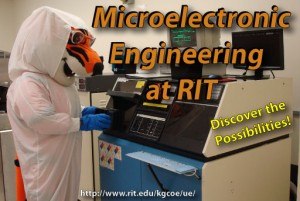Hello high school physics teachers! My name is Rob Pearson, and I’m director of microelectronic engineering programs at Rochester Institute of Technology.
I really like what I do and I want to tell you why. I also want to tell you why I am sharing this with you. I bet you would like to see students more engaged with the concepts you teach and the math employed in your courses. I am an engineer, so I think about problem solving (applications) first and basic science second. But like any good engineer (think MacGyver, to use an outdated reference) I know that I need to be handy with tools like math and physics if I am going to do anything useful. Come to think about it, why didn’t MacGyver ever say he was an engineer? What if your student could help solve challenging problems, use math and science every day, and have a rewarding career and also make a good salary? Typical bachelor of science graduates of RIT’s microelectronic engineering program receive multiple job offers with average starting salaries in the $60-70k range.
Now back to what I do as an electrical engineer. Some aspects of electrical engineering can be dry and theoretical, but I fabricate semiconductor devices — millions of them on a chip and billions of them on each silicon wafer. The process of making these “magical” semiconductor systems is intricate and uses lots of physics, optics, mechanics, chemistry, you name it. So how does this relate to your physics course?  Let me give you some examples. You teach about the Lorentz force and the right-hand rule. You could use a motor winding to illustrate the usefulness but I can give you another example the mixes physics and chemistry. We introduce elements from groups III and V on the periodic table into silicon (group IV) to change the conductivity of the silicon and make our devices. One way to introduce these elements is by ion implantation. Ion implanter functionality is based on the Lorentz force. We use tunable electro-magnets to sort ions in a vacuum by mass to charge ratio and then accelerate them using a variable high-voltage (200,000 V) supply. There is plenty of physics to talk about in this tool. Another example is a micro-electro-mechanical system (MEMS) device called an accelerometer. It consists of a tiny mass on a tiny beam and when the mass is accelerated it produces a proportional electrical signal.
Let me give you some examples. You teach about the Lorentz force and the right-hand rule. You could use a motor winding to illustrate the usefulness but I can give you another example the mixes physics and chemistry. We introduce elements from groups III and V on the periodic table into silicon (group IV) to change the conductivity of the silicon and make our devices. One way to introduce these elements is by ion implantation. Ion implanter functionality is based on the Lorentz force. We use tunable electro-magnets to sort ions in a vacuum by mass to charge ratio and then accelerate them using a variable high-voltage (200,000 V) supply. There is plenty of physics to talk about in this tool. Another example is a micro-electro-mechanical system (MEMS) device called an accelerometer. It consists of a tiny mass on a tiny beam and when the mass is accelerated it produces a proportional electrical signal.
But wait, there’s more! It’s great that I can use these basic science courses and concepts in what I do, but what I really like is communicating the exciting possibilities of what has yet to be designed and built. Look at the changes that have occurred in our phones over just the last five years! They have touch screens, accelerometers, Global Positioning Systems, maps, computers, music players, TVs, videos (3D too!)… they can be video projectors, photo albums, and gaming systems. And that’s just one of many systems that rely on semiconductor products.
What will your students do if they take up a career in this challenging field? Do you remember the tricorder that Dr. McCoy had on Star Trek? That portable medical lab in one compact unit is nearing reality. Great strides are being made in the intersection of electronics, biology, and chemistry. Further miniaturization of electronics is needed to take our current sci fi tech and turn it into practical high tech.
 The biggest challenge I face running an undergraduate college engineering program that focuses on microelectronics and semiconductor processing is finding bright young high school students who even know that this field exists. Please help us spread the word.
The biggest challenge I face running an undergraduate college engineering program that focuses on microelectronics and semiconductor processing is finding bright young high school students who even know that this field exists. Please help us spread the word.
I hope that maybe you can encourage an interested student or two of yours to go on to study microelectronics or nanotechnology in college, and invite you to learn more about our programs and microelectronics by visiting our web page at http://www.rit.edu/kgcoe/ue/.
Sincerely,
Rob Pearson, PhD
Director, Microelectronic Engineering Programs
Rochester Institute of Technology
robert.pearson@rit.edu
(Please note that further information about semiconductors and microelectronics in high school can be found as part of the Semiconductor Technology Enrichment Program materials available at APlusPhysics.com. Special thanks to Dr. Rob Pearson for submitting his article as a guest post to Physics In Flux.)
